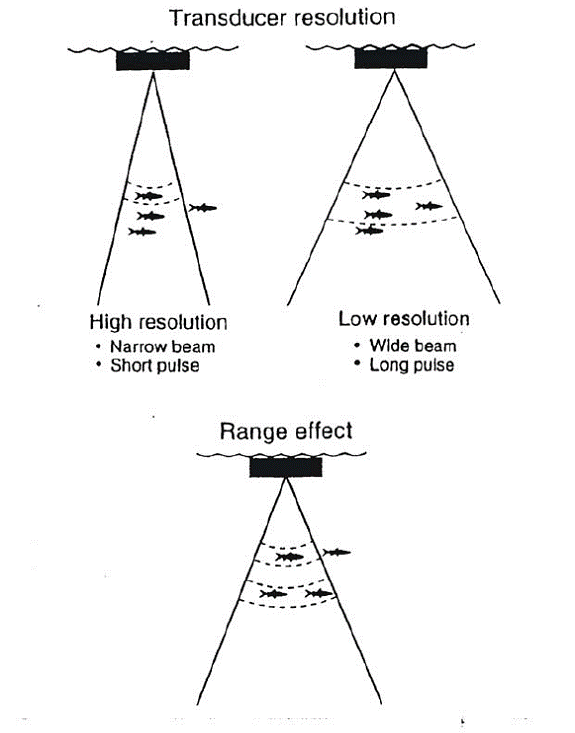Narrow beams (i.e., smaller half intensity beam width) increase horizontal resolution and improve the ability to separate echoes from individual fish (Fig. 6).

Fig. 6. Transducer resolution and beam width. Fish within a pulse volume (delineated with dashed lines) cannot be resolved separately. More fish are within a pulse volume when the pulse duration is longer and when the beam is wider. Reproduced from Brandt (1996) with permission from the American Fisheries Society.
Narrower beam angles have smaller bottom dead zones. In deadzone height calculation example (120 kHz, θ3 dB=7º, depth=100 m) we had a bottom dead zone of 0.5 m. A narrower beam (120 kHz, θ3 dB=5º, depth=100 m) would have a dead zone value of 0.4 m.
A narrow beam requires a greater active area of transducer elements than does a wide beam at the same frequency. In the near-field distance calculation example, a 7o, 120 kHz transducer has an active radius of 5.0 cm and a "safe" near-field value of 1.7 m. A 4o 120 kHz transducer would have an active radius of 8.8 cm and therefore a near-field value of 2.6 m.
Wider beams allow for a greater sampling volume, an advantage when fish abundance is low, but are more sensitive to omni-directional background noise than narrow beams (Simmonds and MacLennan 2005), making a narrow beam a better choice in noisy environments (Table 3).
Table 3. Comparison between wide and narrow beam attributes.
Attribute |
Wide beam |
Narrow beam |
Depth penetration |
lower |
higher |
Horizontal extent |
higher |
lower |
Horizontal resolution at depth |
lower |
higher |
Near-field |
lower |
higher |
Deadzone |
higher |
lower |
Ambient noise levels |
higher |
lower |
Data from wider beam transducers are less affected by vessel motion as the greater ping-to-ping overlap in the insonified volume will result during pitch/roll.
Transducers with wider beam widths are smaller than narrow beam transducers. This is a consideration for portable acoustic systems.
Typical beam widths used in the Great Lakes are between 6º to 12º.